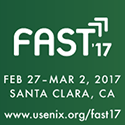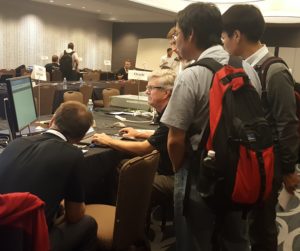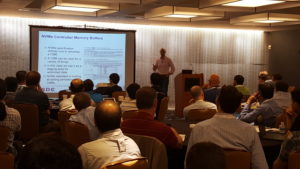SNIA will be out and about in February in San Francisco and Santa Clara, CA, focused on their security, container, and file storage activities.
 February 14-17 2017, join SNIA in San Francisco at the RSA Conference in the OASIS Interop: KMIP & PKCS11 booth S2115. OASIS and SNIA member companies will be demonstrating OASIS Key Management Interoperability Protocol (KMIP) through live interoperability across all participants. SNIA representatives will be on hand in the booth to answer questions about the Storage Security Industry Forum KMIP Conformance Test Program, which enables organizations with KMIP implementations to validate the protocol conformance of those products and meet market requirements for secure, plug-and-play storage solutions. And Eric Hibbard, Chair of the SNIA Security Technical Work Group and CTO Security and Privacy, HDS Corporation, will participate in the “Can I Get a Witness? Technical Witness Bootcamp” session on February 17.
February 14-17 2017, join SNIA in San Francisco at the RSA Conference in the OASIS Interop: KMIP & PKCS11 booth S2115. OASIS and SNIA member companies will be demonstrating OASIS Key Management Interoperability Protocol (KMIP) through live interoperability across all participants. SNIA representatives will be on hand in the booth to answer questions about the Storage Security Industry Forum KMIP Conformance Test Program, which enables organizations with KMIP implementations to validate the protocol conformance of those products and meet market requirements for secure, plug-and-play storage solutions. And Eric Hibbard, Chair of the SNIA Security Technical Work Group and CTO Security and Privacy, HDS Corporation, will participate in the “Can I Get a Witness? Technical Witness Bootcamp” session on February 17.
 The following week, February 21-23, join SNIA at Container World in Santa Clara CA. Enabling access to memory is an important concern to container designers, and Arthur Sainio, SNIA NVDIMM Special Interest Group Co-Chair from SMART Modular, will speak on Boosting Performance of Data Intensive Applications via Persistent Memory. Integrating containers into legacy solutions will be a focus of a panel where Mark Carlson, SNIA Technical Council Co-Chair from Toshiba, will speak on Container Adoption Paths into Legacy Infrastructure. SNIA experts will be joined by other leaders in the container ecosystem like Docker, Twitter, ADP, Google, and Expedia . The SNIA booth will feature cloud infrastructure and storage discussions and a demonstration of a multi-vendor persistent memory solution featuring NVDIMM! (P.S. – Are you new to containers? Get a head start on conference discussions by checking out a December 2016 SNIA blog on Containers, Docker, and Storage.)
The following week, February 21-23, join SNIA at Container World in Santa Clara CA. Enabling access to memory is an important concern to container designers, and Arthur Sainio, SNIA NVDIMM Special Interest Group Co-Chair from SMART Modular, will speak on Boosting Performance of Data Intensive Applications via Persistent Memory. Integrating containers into legacy solutions will be a focus of a panel where Mark Carlson, SNIA Technical Council Co-Chair from Toshiba, will speak on Container Adoption Paths into Legacy Infrastructure. SNIA experts will be joined by other leaders in the container ecosystem like Docker, Twitter, ADP, Google, and Expedia . The SNIA booth will feature cloud infrastructure and storage discussions and a demonstration of a multi-vendor persistent memory solution featuring NVDIMM! (P.S. – Are you new to containers? Get a head start on conference discussions by checking out a December 2016 SNIA blog on Containers, Docker, and Storage.)
 Closing out February, find SNIA at their booth at USENIX FAST from February 27-March 2 in Santa Clara, CA, where you can engage with SNIA Technical Council leaders on the latest activities in file and storage technologies.
Closing out February, find SNIA at their booth at USENIX FAST from February 27-March 2 in Santa Clara, CA, where you can engage with SNIA Technical Council leaders on the latest activities in file and storage technologies.
We look forward to seeing you at one (or more) of these events!
 c Storage, and SMB3 plugfests; ten Birds-of-a-Feather Sessions, and amazing networking among 450+ attendees. Sessions on NVMe over Fabrics won the title of most attended, but Persistent Memory, Object Storage, and Performance were right behind. Many thanks to SDC 2016 Sponsors, who engaged attendees in exciting technology discussions.
c Storage, and SMB3 plugfests; ten Birds-of-a-Feather Sessions, and amazing networking among 450+ attendees. Sessions on NVMe over Fabrics won the title of most attended, but Persistent Memory, Object Storage, and Performance were right behind. Many thanks to SDC 2016 Sponsors, who engaged attendees in exciting technology discussions. You’ll want to stream keynotes from Citigroup, Toshiba, DSSD, Los Alamos National Labs, Broadcom, Microsemi, and Intel – they’re available now on demand on SNIA’s YouTube channel,
You’ll want to stream keynotes from Citigroup, Toshiba, DSSD, Los Alamos National Labs, Broadcom, Microsemi, and Intel – they’re available now on demand on SNIA’s YouTube channel, ![DataStorageSecuritySummitlogo200x199[1]](https://sniablog.org/wp-content/uploads/2015/09/DataStorageSecuritySummitlogo200x1991.png)
